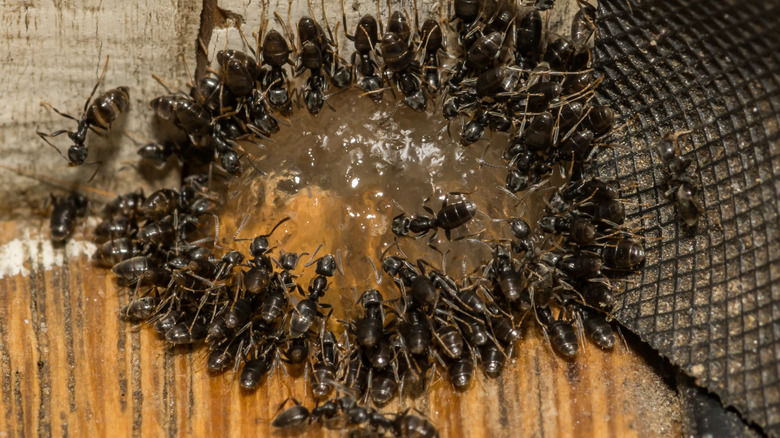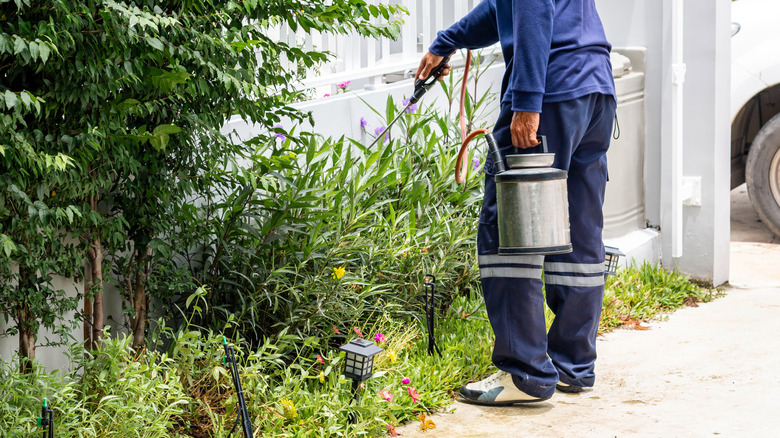The Unmistakeable Smell That Means Odorous Ants Are Living In Your Home
We may receive a commission on purchases made from links.
Ants are a common sight during warmer months, but there's one species that makes its presence known with an unmistakable scent. Odorous house ants are tiny brown insects with one significant signifier: a pungent smell they emit when crushed or stepped on. The scent is often described as similar to rotten coconuts, making some call them coconut ants or stink ants. That said, this ant by any other name doesn't smell as sweet, as the foul odor can be overpowering, especially when crushing more than one. It's not only unpleasant, it's a warning sign that odorous house ants are in your home.
Some of the most common house ants, odorous ants require a careful approach. Although they're not dangerous and don't bite unless provoked, the scent they leave behind is enough to drive you out. Like other ants, they can quickly contaminate your food as they search for their favorites, namely anything sugary contained within your home. However, they have an ability to feed on many different types of food, creating the possibility they can contaminate multiple things within your kitchen's pantry or cabinet. You may be able to distinguish coconut ants from other species, but their miniature size can make it difficult. They measure around 1 1/2 millimeters to 3 millimeters long with an uneven thorax on their dark brown to black bodies. These ants may be hiding in unexpected spots in your home, seeking out warm, moist areas such as near the hot water heater or pipes. You'll find them often nesting in void spaces, including those created by termites. Once they're in your home, it's hard to clear out an infestation.
How to get rid of odorous ants
The best way to get rid of these stinky ants is with a two-step approach because they're tenacious and smart. You can't just squish them and be done with it, as their scent makes the problem worse. First, you'll need to figure out where they're coming in. You can do so by tracking them to their nests and applying an insecticide, if possible. You'll want to observe coconut ants' actions, finding possible entry points, such along the window frame, under your sliding glass door, and near heating ducts.
After sealing any cracks and crevices where they may enter, set up ant baits. You can buy a manufactured ant bait to help manage them, or use a DIY option, mixing one part borax and three parts sugar dissolved in water. Set the sugar and borax paste inside of a container, such as a plastic bottle, enticing the worker ants to bring the food back to the colony. You will need to keep an eye on your baits, refreshing as needed. There are also few insecticides that can help manage the problem of odorous ants. These options include Terro PCO Liquid Ant Killer and Advance 375a Select Granular Ant Bait. Whichever brand you use, always follow the directions on the bait or insecticide, keeping it out of reach of children or pets.
Prevention and when to call a pest control expert
While waiting for the ants to literally take the bait, make entry harder. Start by trimming trees and shrubbery, and moving any wood piles away from your home. Eliminate any sources of moisture, such as leaking pipes or overflowing gutters, eliminating outdoor sources of standing water. Be vigilant on your home's cleanliness by wiping up any food or drink spills, sweeping up crumbs, and taking out your trash regularly. Odorous ants are opportunistic eaters, often dining on fruit, meat, vegetables, and dairy. Clean any spots with ant activity with soap and water to wipe away the pheromone trails ants leave, eliminating the chance other ants may follow. Seeing odorous house ants continually after treating them may be a sign it's time to call the pest control professionals. Coconut ants have more than one queen in their colonies, and some even form so-called super colonies, with multiple satellite nests connected to them.
It's entirely possible ants from multiple colonies could enter your home by following the trails left behind other ants, and DIY methods aren't enough to bring down the infestation. They can reproduce multiple times through the year, and multiple queens may produce eggs, quickly turning a few ants into a large infestation in no time. What's more, they have a keen sense for foraging, often traveling along trails spanning 33 to 157 feet. Once disturbed, they may relocate their nests, meaning you could end up constantly having to play catch-up as you attempt treating an infestation only to have another pop up. If you feel you're fighting a losing battle, call a professional before the problem gets too much worse.


